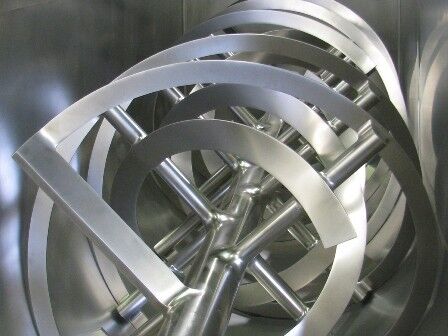Ribbon Blenders
Ribbon blenders are one of the oldest automated mixing methodologies and use u-shaped troughs with opposing sets of helical agitators—one inner, and one outer. By forming 2 opposing cyclones within the product, they create homogeneous mixes quickly but create some heat and can degrade sensitive products.

Features and Benefits:
Ribbon blenders offer a range of features and benefits that make them ideal for food processors, including:
- High mixing efficiency: Ribbon blenders feature a unique design that ensures thorough blending of ingredients in a relatively short period of time, reducing the risk of over-processing or damage to fragile ingredients.
- Customizable design: We can work with you to customize the size, shape, and materials of your ribbon blender to fit your specific application, ensuring optimal blending performance and minimal waste.
- Easy maintenance: Ribbon blenders are designed to be easy to clean and maintain, with access to all critical components for routine inspections and maintenance.
- Durability and reliability: We use only the highest quality ribbon blenders, ensuring that they can withstand the rigors of continuous use and provide reliable performance for years to come.
Applications
Ribbon blenders are suitable for a wide range of food processing applications, including:
- Mixing dry and semi-dry ingredients for baked goods, snack foods, and cereals
- Blending powders, spices, and seasonings for sauces, marinades, and dressings
- Homogenizing dry ingredients for nutritional supplements and pet foods
- Combining dry ingredients for spice blends, dry mixes, and other food products
When to use ribbon blenders:
- When blending dry or semi-dry ingredients, such as powders, granules, and pellets
- When blending multiple ingredients with varying densities and particle sizes
- When batch mixing is required, with each batch being homogenized before unloading
When not to use ribbon blenders:
- When blending liquids or wet ingredients, as ribbon blenders are generally not designed to handle fluids and may cause lumping (this is not a strict rule, as some models are made to accommodate liquid)
- When product is friable/delicate or sensitive to heat, as ribbon blenders create heat
- When high-speed mixing or shearing is required, as ribbon blenders typically operate at slower speeds and are not suitable for emulsifying or homogenizing materials
- When the ingredients being mixed require a specific type of mixing action, such as a tumbling or rolling motion, rather than the back-and-forth movement of ribbon blades
Integration and Support
Our engineers and fabricators can work with you to integrate the right ribbon blenders seamlessly into your existing production line, ensuring optimal performance and efficiency. We also offer ongoing support and maintenance services to ensure that your ribbon blender continues to operate at peak performance for years to come.